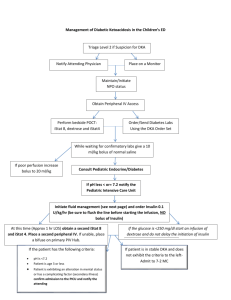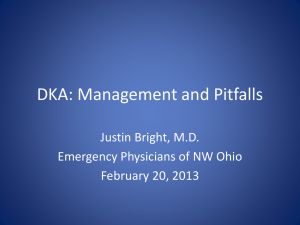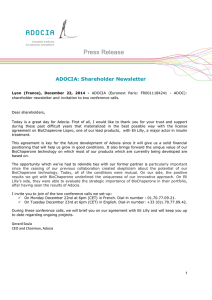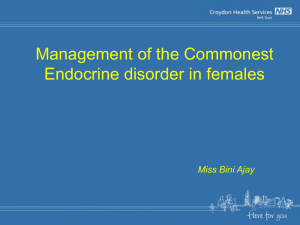Journal Club slides
advertisement
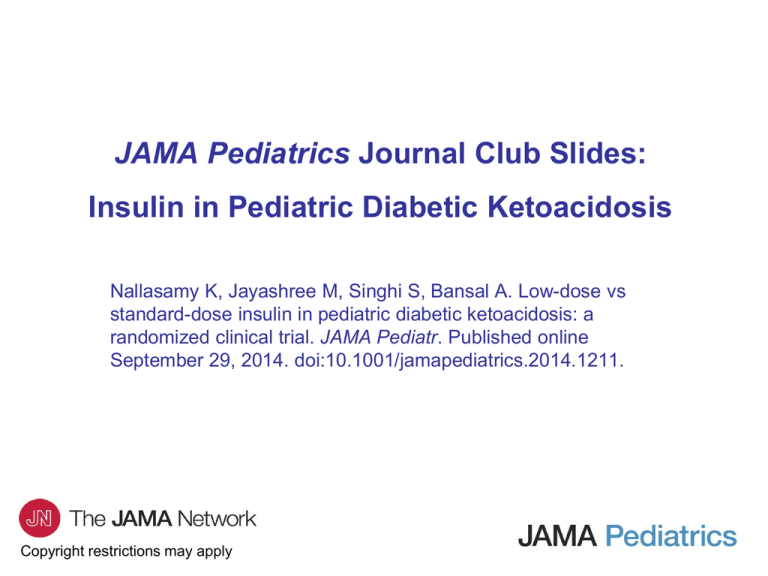
JAMA Pediatrics Journal Club Slides: Insulin in Pediatric Diabetic Ketoacidosis Nallasamy K, Jayashree M, Singhi S, Bansal A. Low-dose vs standard-dose insulin in pediatric diabetic ketoacidosis: a randomized clinical trial. JAMA Pediatr. Published online September 29, 2014. doi:10.1001/jamapediatrics.2014.1211. Copyright restrictions may apply Introduction Background • Standard recommended dose (0.1 U/kg/h) of insulin in diabetic ketoacidosis (DKA) guidelines is not backed by strong clinical evidence. • Physiologic dose-effect studies have found that even lower doses could normalize ketonemia and acidosis. • Lowering the insulin dose may be advantageous in the initial hours of therapy when a gradual decrease in glucose, electrolytes, and osmolality is desired. Study Objective • To compare the efficacy and safety of low-dose insulin against the standard dose in children with DKA. Copyright restrictions may apply Methods • Study Design: Prospective, open-label randomized clinical trial. • Setting: Pediatric emergency department and intensive care unit of a tertiary care teaching hospital in northern India from November 1, 2011, through December 31, 2012. • Patients: Fifty consecutive children 12 years or younger with a diagnosis of DKA were randomized to low-dose (0.05 U/kg/h; n = 25) and standarddose (0.1 U/kg/h; n = 25) groups. – Children were excluded if they had symptomatic cerebral edema, septic shock at presentation, anuria for longer than 6 hours, or insulin treatment before admission. Copyright restrictions may apply Methods Primary Outcome • Rate of decrease in blood glucose (BG) until a level of 250 mg/dL or less is reached. Secondary Outcomes • Time to resolution of acidosis. • Episodes of treatment failures. • Incidences of hypokalemia and hypoglycemia. Limitations • Open-label design. • Adolescent children not enrolled. • A possibly stringent noninferiority margin of 18 mg/dL/h. Copyright restrictions may apply Results Trial Flow Copyright restrictions may apply Results Baseline Demographic and Biochemical Characteristics Characteristic Low-Dose Group Standard-Dose Group (n = 25) (n = 25) 7.3 (3.8) 6.5 (3.6) 9/16 11/14 Children with malnutrition, No. (%) 7 (28) 8 (32) New-onset DKA, No. (%) 13 (52) 16 (64) BG, mean (SD), mg/dL 485.3 (133) 524.4 (103) pH, mean (SD) 7.08 (0.12) 7.05 (0.11) 6.2 (2.6) 7.0 (3.1) 133.0 (7.0) 134.5 (10.0) 4.8 (0.8) 4.7 (0.7) 292.0 (13.8) 298.2 (21.2) Age, mean (SD), y Male/female, No. Bicarbonate, mean (SD), mEq/L Sodium, mean (SD), mEq/L Potassium, mean (SD), mEq/L Effective osmolality, mean (SD), mOsm/kg Copyright restrictions may apply Results Primary Outcome for Low-Dose vs Standard-Dose Insulin • Mean (SD) rate of BG decrease until 250 mg/dL or less is reached: 45.1 (17.6) vs 52.2 (23.4) mg/dL/h. • Mean (SD) time taken to achieve this target: 6.0 (3.3) vs 6.2 (2.2) hours. • Mean (SD) BG decrease in the first hour of insulin: 39.2 (25.5) vs 61.3 (37.7) mg/dL/h. Copyright restrictions may apply Mean BG Decrease With Insulin Therapy Results Secondary Outcome Measures Copyright restrictions may apply Comment • Low-dose insulin achieved a clinically effective BG reduction that was comparable to the standard dose. • Time to resolution of acidosis was similar in both groups, suggesting that the low dose could be as effective as the standard dose in suppressing lipolysis and ketogenesis. • Gradual BG decrease in the initial hour and a tendency toward fewer episodes of hypokalemia suggest that the lower dose could be safer (higher insulin in the first few hours can cause a precipitous BG decrease and rapid electrolyte shifts, thus increasing the risk of cerebral edema). Copyright restrictions may apply Conclusions • Low-dose insulin is noninferior to standard-dose insulin with respect to the rate of BG decrease and resolution of acidosis. • This study opens the door for a subsequent superiority trial with a larger sample size to explore differences in the rate of BG decrease before 0.05 U/kg/h replaces 0.1 U/kg/h in the practice recommendations. Copyright restrictions may apply Contact Information • If you have questions, please contact the corresponding author: – Muralidharan Jayashree, MD, Department of Pediatrics, Postgraduate Institute of Medical Education and Research, Sector 12, Chandigarh, India 160012 (mjshree@hotmail.com). Conflict of Interest Disclosures • None reported. Copyright restrictions may apply
